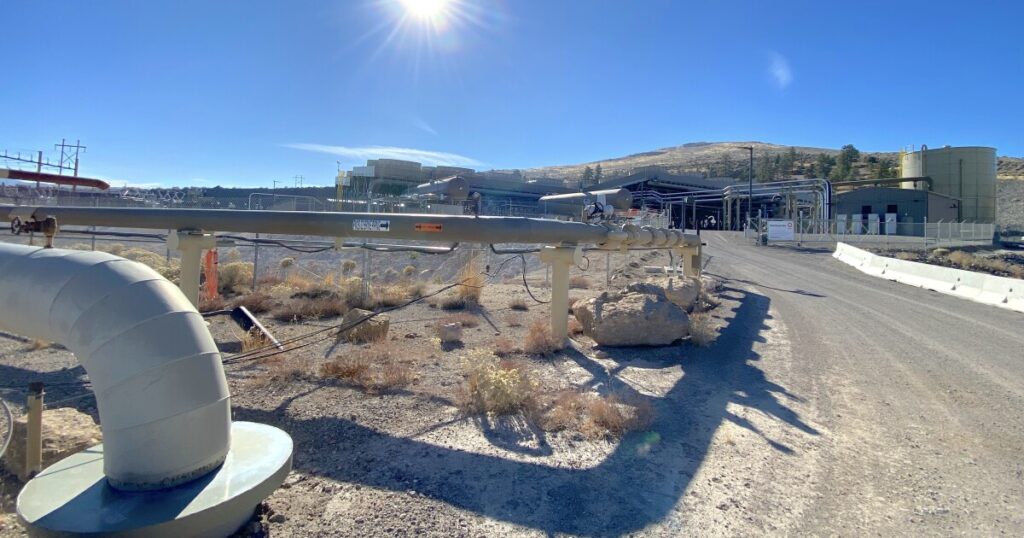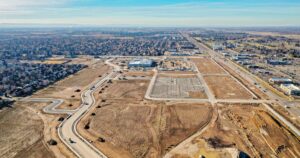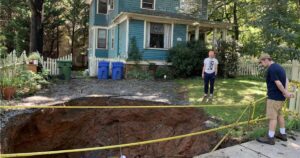In south Reno, wild horses roam a sagebrush landscape where the continuous hum of turbines marks the presence of Ormat Technologies’ geothermal power plant. This facility, resembling an intricate assembly of interconnected pipes and machinery, operates non-stop, harnessing the earth’s underground heat.
Marisol Collons from Ormat explains the geothermal process: “We’re looking for temperatures, on average between 270 and 325 Fahrenheit.” This heat is accessed by extracting hot water from deep underground using high-pressure wells. As the water reaches the surface, it turns to steam, driving the turbines to generate electricity.
Kaleb Roedel
/
Mountain West News Bureau
With its Steamboat Hills complex of six power plants, Ormat produces approximately 100 megawatts, powering around 80,000 homes. Nevada, as a whole, generates more than 800 megawatts of geothermal energy, ranking second in the nation after California and contributing nearly 10% of the state’s electricity supply.
Jim Faulds, associate director of the Nevada Bureau of Mines and Geology, highlights Nevada’s geothermal potential, noting, “The region that we live in is one of the largest geothermal provinces on Earth.” He explains that the state’s crust is extending, resulting in Nevada growing by about two acres annually. This geological activity brings warmer sections of the earth closer to the surface, providing increased geothermal opportunities.
The Nevada Division of Minerals has seen a surge in geothermal exploration permits, with Dustin Holcomb, the agency’s fluid minerals manager, reporting a record number of applications this year. This increase in activity is also reflected in state revenue, with Nevada collecting $14.3 million from geothermal leases and royalties last year, significantly higher than in previous years.
Beyond Nevada, other states are also tapping into geothermal resources. Idaho boasts the nation’s largest geothermal heating system in Boise, while New Mexico hosts a large-scale geothermal plant in its southern region. Colorado is encouraging geothermal development through grants and tax credits.

U.S. Department of Energy
In Utah, the U.S. Department of Energy is investing heavily in enhanced geothermal systems (EGS), which involve creating artificial reservoirs using techniques akin to oil and gas fracking. Lauren Boyd from the DOE’s geothermal technologies office is optimistic about this “next-generation geothermal” technology, which she believes could significantly expand across the nation.
The DOE is testing EGS at the FORGE project in Utah, while nearby, Fervo Energy is constructing the largest enhanced geothermal plant worldwide. The DOE aims for geothermal energy to provide 10% of the U.S. electricity by 2050, a significant increase from its current contribution of less than 0.5%.
However, geothermal energy development has its critics. Patrick Donnelly from the Center for Biological Diversity expresses concerns over environmental impacts, citing a controversial Ormat project that threatened the habitat of the endangered Dixie Valley toad in Nevada. He claims, “Geothermal power plants dry up hot springs or change their flow significantly,” impacting ecosystems.

Patrick Donnelly
/
Center for Biological Diversity/
Ormat counters these concerns, with Kayla Dowty, the company’s director of business development, stating that their operations do not dry up hot springs as they recycle water by reinjecting it back into the reservoirs. Dowty emphasizes geothermal’s advantage in land use efficiency compared to other renewables like wind and solar, noting its consistent power generation regardless of weather conditions.
As a note of disclosure, Ormat is a financial supporter of KUNR.
This story was produced by the Mountain West News Bureau, a collaboration between Wyoming Public Media, Nevada Public Radio, Boise State Public Radio in Idaho, KUNR in Nevada, KUNC in Colorado, and KANW in New Mexico, with support from affiliate stations across the region. Funding for the Mountain West News Bureau is provided in part by the Corporation for Public Broadcasting.





